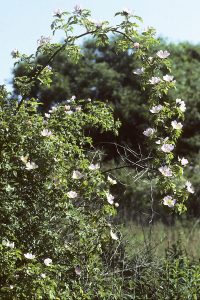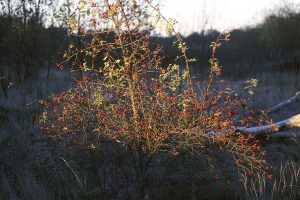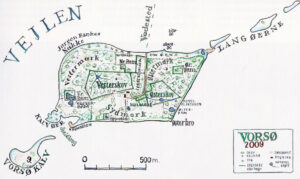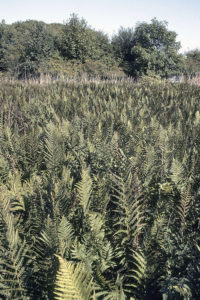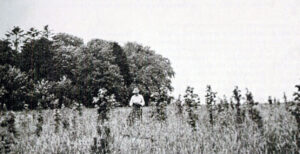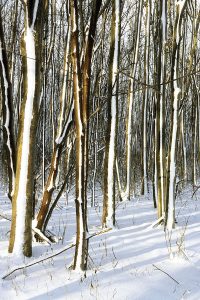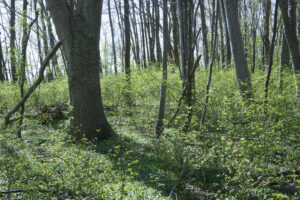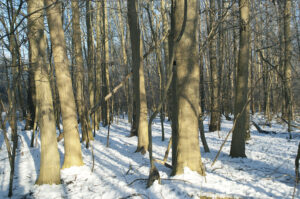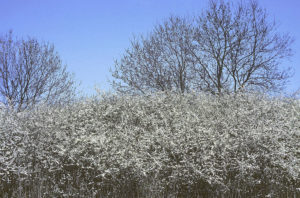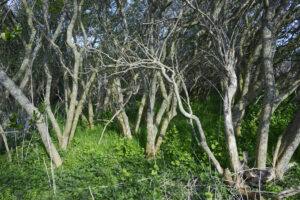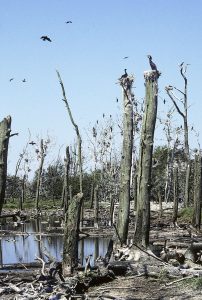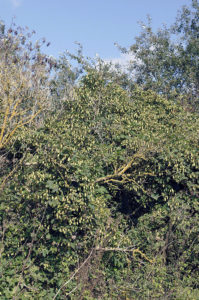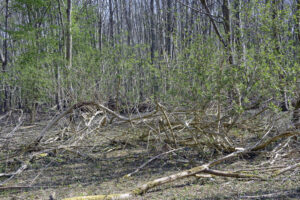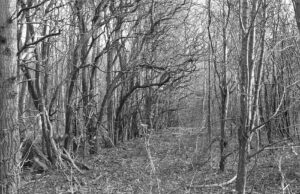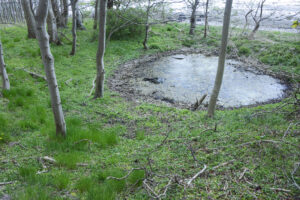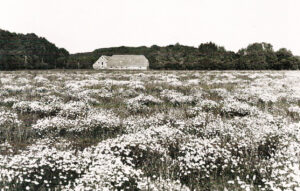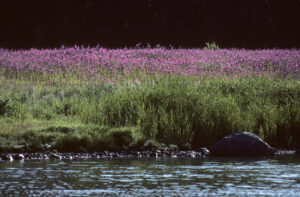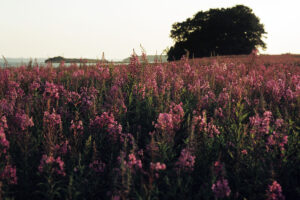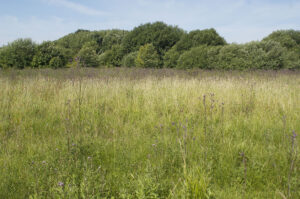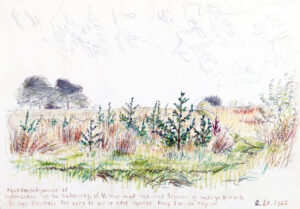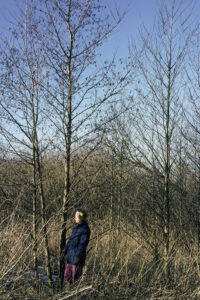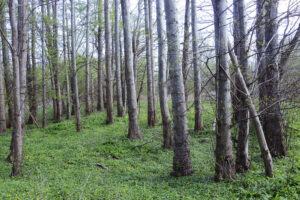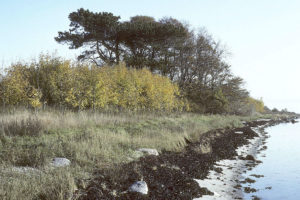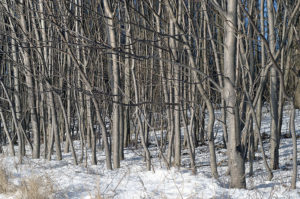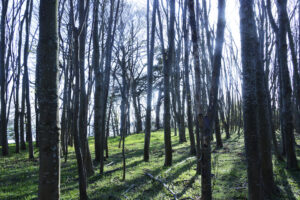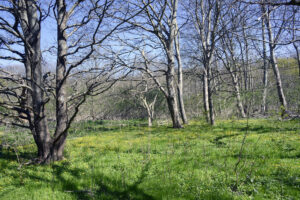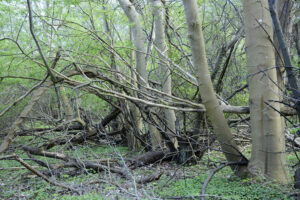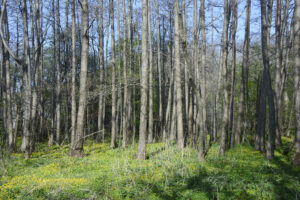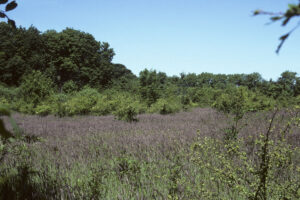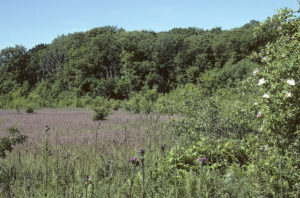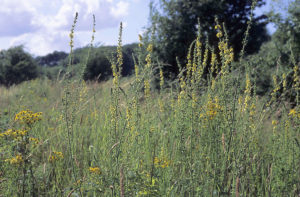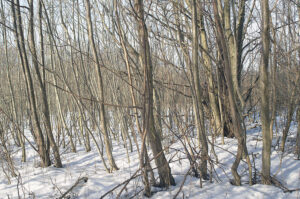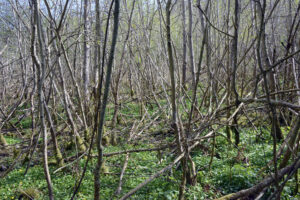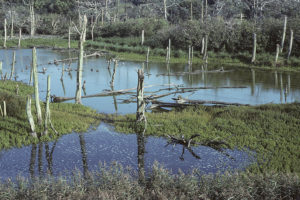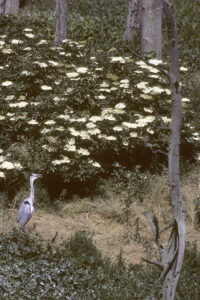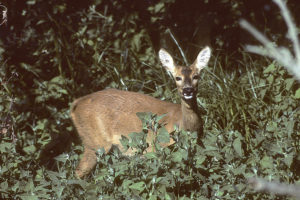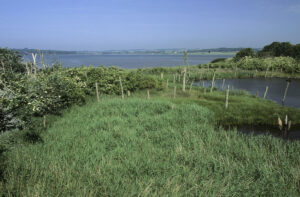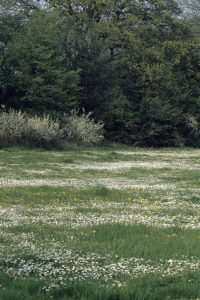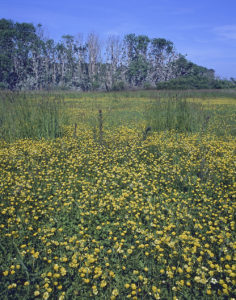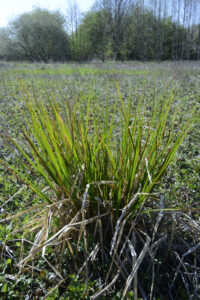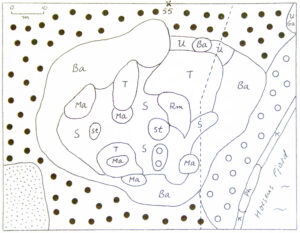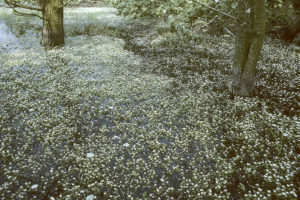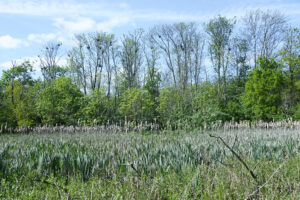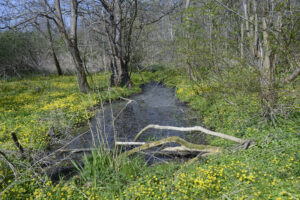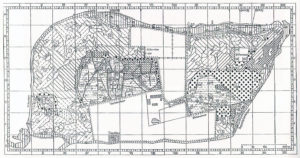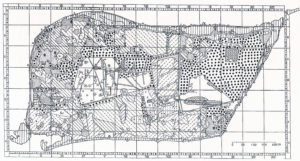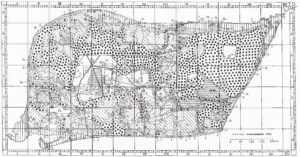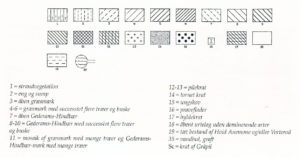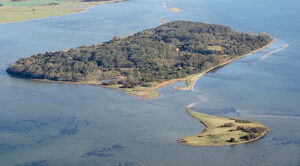Expanding wilderness
Dog rose (Rosa canina) is abundant on Vorsø, and for many years this species dominated large areas on the fields, which were protected in 1928, here on the eastern field, June 23, 1983 (top). Later, it became very common on the fields, which were protected in 1978. The lower picture is from the central field, where hundreds of rose hips are glowing in the evening sun, November 1990. (Photos copyright © by Kaj Halberg)
Kaj Halberg
As mentioned on the page Vorsø on my mind, three quarters of Vorsø – a total of 45 hectares – were fully protected, when Copenhagen University took over the island in December 1928, i.e. humans were not allowed to interfere in the course of nature.
Soon the well-managed woods, plantations, and fields began looking less well-managed. Wind-fallen trees were left where they fell, and draining ditches and field tracks were soon overgrown by herbs and bushes.
This description of the vegetation succession on the former arable land is for the major part based on surveys of the vegetation of the island, undertaken during the 1950s by Professor Knud Jessen (Jessen 1968), and by myself in 1991-92 (Halberg 1996), and in 2006 (Halberg 2006). These surveys are presented in figs. 4-6, at the bottom of this page.
The vegetation succession in the forests and plantations on the island is described by Dal & Fabricius (2013).
When you encounter names of localities in the text, see fig. 1.
Fig. 1. Map, showing the most important names of localities on Vorsø. (Drawing copyright © by Jens Gregersen)
The old protected fields
Grass cover expelled by tall herbs and trees
In 1929, the agricultural areas, which were abandoned in 1928, Vestermark (‘western field’) and Østermark (‘eastern field’) – today called ’the old protected fields’ – were covered by mainly annuals and biennials, dominated by Leucanthemum vulgare and Matricaria perforata. Other species, such as Rumex acetosella, Prunella vulgaris, and Aphanes arvensis were also very common.
As early as 1933, most of these species had been replaced by various grasses, e.g. Agrostis capillaris, Dactylis glomerata, and Holcus lanatus, together with Cirsium arvense, Rubus idaeus, and others.
The grass cover was slowly replaced by communities of taller plants, dominated by Chamaenerion angustifolium and Rubus idaeus, and, to a lesser extent, Cirsium arvense and Urtica dioica. After 1955, however, Chamaenerion quickly began to expel the other species. Aerial photographs show that many of the growths were circular, indicating spreading by subterraneous runners. This explosive spreading was also caused by the fact that Chamaenerion is very competitive. It is tall, and its withered foliage contains chemicals, which inhibit growth of other species. The rich soil on Vorsø was also beneficial to the species.
In 1962, the distribution of grassy areas and the Chamaenerion-Rubus community on the fields was about equal, namely 45% each, while young woods and bushes covered 10%.
Since then, young woods and shrubs have been steadily spreading, and today only small areas with grass cover, Chamaenerion-Rubus community, and meadows with tall perennials remain on Vestermark. During the 1980s, in the south-eastern part of this field, several grassy areas were taken over by Dryopteris filix-mas and a few Athyrium filix-femina, the former today covering large areas. The only remaining larger area with grass cover is found south of Vestre Remise, and it is obvious that grazing roe deer have delayed the succession.
Until the 1980s, the south-western part of Vestermark was dominated by grasses. This picture shows a large growth of Arrhenatherum elatius near the south-western tip of the island, August 2, 1976. The reddish parts are Chamaenerion. In the background Vestre Remise with breeding cormorants. (Drawing copyright © by Jens Gregersen)
During the 1980s, several grassy areas on the western field were taken over by Dryopteris filix-mas, which, since then, has spread even more, today covering large areas. – September 17, 1992. (Photo copyright © by Kaj Halberg)
Young forest and impenetrable thickets
Along the two old forests, Østerskov (’eastern forest’) and Vesterskov (’western forest’), the grass cover was mixed with young trees, especially Fraxinus excelsior and Acer pseudoplatanus, whose seeds are widely dispersed by the wind. On November 24, 1928, eastern Jutland was ravished by a hurricane-like storm from the south-west, causing seeds of predominantly these two species, and Ulmus glabra, to spread from the eastern wood all over the abandoned Østermark (‘eastern field’), north-east of Østerskov. Seeds of Fagus sylvatica are too heavy to be wind-spread, so this species was not able to establish itself here.
Acer pseudoplatanus quickly took over most of this area, covering an area of c. 8 hectares (fig. 6). Initially, Fraxinus, Ulmus, Acer platanoides, and Abies alba took part in the competition, but only a few specimens of the former three were able to reach the crown layer.
During the 1990s, Dutch elm disease (see page Dutch elm disease on Vorsø) killed all larger Ulmus in the young wood on Østermark, but to this day, new specimens sprout constantly. Various shrubs formerly grew on the forest floor, including Rosa canina, Corylus avellana, Viburnum opulus, Crataegus laevigata and C. monogyna, and Sambucus nigra. Today, the forest floor here is very dark due to the dense foliage of Acer pseudoplatanus, and no bushes grow here, apart from Sambucus, which forms brushwood here and there, and a few Crataegus.
The grass cover soon disappeared from this young wood, and, since around 1980, the forest floor has been partly covered by dense growths of shadow-tolerant herbs, predominantly Circaea lutetiana, Geranium robertianum, and Geum urbanum. Near a former clay pit in the north-eastern corner of the field, Sanicula europaea and Brachypodium sylvaticum are numerous.
Other places on the island, formation of forest initially only took place near the edges of the old forests. Today, these young woods are dominated by Fraxinus and Acer pseudoplatanus, with species like Corylus, Salix caprea, and Crataegus laevigata in the bush layer.
In a small area of Østermark, between Østerskov and the road, a dense growth of Alnus glutinosa was established shortly after 1928, and by 1936 the trees were already 4 m tall. Later, Fraxinus invaded this area, and today almost all Alnus have disappeared.
During the 1970s and 1980s, huge thickets of Prunus spinosa, P. cerasifera, Rosa canina, Crataegus monogyna, Sambucus, and Salix cinerea were established many places on the old fields, often being so dense that they were impenetrable. In the same period, small groups of young trees were established here and there on the fields, dominated by Fraxinus and Acer pseudoplatanus, mixed with Ulmus, Quercus robur, Corylus, Salix caprea, and Betula pendula.
From the plantation Vestre Remise (see caption Swamp like in the 1700s below), Populus x canescens spread into the surrounding field by root shoots, forming a young wood, which, however, was soon severely damaged by breeding cormorants. Beneath this young wood, very dense Sambucus shrubs were formed. Humulus lupulus, which grew in Vestre Remise, soon spread to the surrounding areas of Vestermark, and today bushes in a larger area near the plantation are completely overgrown by this vigorous vine.
By 2006, on the old fields, young forest had almost completely replaced the former grassy areas, as well as the Chamaenerion-Rubus community, and shrubs were also slightly declining. The forest floor in these young woods was still quite open, and a large number of various herbs grew here, especially Circaea lutetiana, Geum urbanum, and Mercurialis perennis, besides many others, including Dryopteris filix-mas, D. dilatata, Allium ursinum, Galium aparine, Polygonatum multiflorum, Silene dioica, Geranium robertianum, and Ajuga reptans. In young woods near the northern coast, species like Anthriscus sylvestris, Sanicula, Polygonatum multiflorum, and Alliaria petiolata dominated.
During the 2010s, many of the thickets on the old fields, consisting of Prunus spinosa, P. cerasifera, Rosa canina, Crataegus monogyna, Sambucus, and Salix cinerea, broke down from old age, and in these areas, lots of Fraxinus and Acer pseudoplatanus are sprouting.
Plant registration in the 1930s among young Acer pseudoplatanus on the abandoned field Østermark, north-east of Østerskov. A few years later, this species became overwhelmingly dominant in the established young wood. Today, this area is covered by a dense forest of 90-year-old trees. (Photo from Wiinstedt 1938)
The same young wood as above, December 13, 1981. Østermark is now completely dominated by Acer pseudoplatanus, about 50 years old. (Photo copyright © by Kaj Halberg)
Young wood of Acer pseudoplatanus, with an abundance of young Ulmus, in the north-eastern corner of Østermark, April 27, 2022. (Photo copyright © by Kaj Halberg)
In the 1960s, Alnus glutinosa was dominating in a small part of the south-western corner of Østermark, and a wood of tall trees was present by the 1980s. However, as soon as 1991, the wood had been taken over by Fraxinus. This picture, from January 28, 2006, shows pale trunks of Fraxinus with a few darker Alnus trunks. (Photo copyright © by Kaj Halberg)
During the 1970s and 1980s, huge thickets of thorny bushes were established in many places on the old fields, often being so dense that they were impenetrable. This picture shows flowering Prunus spinosa on Vestermark, May 12, 1988. (Photo copyright © by Kaj Halberg)
Euonymus europaeus forms rather dense thickets several places on the island, in this case at the outskirts of Vestermark, near the western coast, April 27, 2022. The herbs beneath the bushes are Alliaria petiolata, Urtica dioica, and Ranunculus ficaria. (Photo copyright © by Kaj Halberg)
With the rising groundwater level in the reserve, the growth of Populus x canescens in the centre of the plantation Vestre Remise died, but, prior to their death, they had spread into the surrounding field by root shoots, forming a young wood, which, however, was soon severely restricted by breeding cormorants. – May 16, 1988. (Photo copyright © by Kaj Halberg)
Humulus lupulus soon spread from Vestre Remise, and today bushes in a larger area near the plantation is completely overgrown by this vigorous vine, in this case an old Sambucus nigra. In the background, a young wood of Populus x canescens has been established. – September 10, 2013. (Photo copyright © by Kaj Halberg)
Sambucus shrubs on Østermark, dying of old age, April 27, 2022. (Photo copyright © by Kaj Halberg)
Østre Remise was a small plantation, covering about 0.4 ha, established around 1920 in the centre of Østermark. The western border of this plantation consisted of a hedge of Crataegus monogyna, about 60 years old in this picture from May 1, 1978. In 2006, they were dying, and in 2022 the last remains had sunk into the forest floor. (Photo copyright © by Kaj Halberg)
Tepotten (‘the tea pot’) is a tiny plantation near the southern coast, covering about 400 m2, established in the late 1800s. The name stems from a tiny waterhole in the plantation. This picture from April 29, 2022 shows Acer pseudoplatanus, Fagus sylvatica, Fraxinus, Alnus incana, Poa nemoralis, Taraxacum, and others. (Photo copyright © by Kaj Halberg)
The new protected fields
Sydmark and Nordmark – from fields to raspberry shrubs and young woods
Three fields on the island, altogether covering 14 hectares, were cultivated until 1978, Sydmark (‘southern field’), Nordmark (‘northern field’), and Centralmark (‘central field’) – today called ’the new protected fields’. In autumn 1978, the major part of these fields was ploughed, whereas 2.5 ha were left as a stubble field. The central field had an orchard, in which the trees were felled in 1981.
Similar to the development on the old protected fields around 1930, the new protected fields, for a few years, were completely dominated by annuals and biennials, in particular Matricaria perforata and Elymus repens. The latter, which had been a common weed on the arable land, soon took over large areas of the ploughed fields, together with Taraxacum and others. Elymus repens is able to withstand ploughing, as even a tiny part of its rhizome can sprout into a new plant.
In 1979, on the stubble field, seeds of Chamaenerion were at once able to sprout, spread from a dense growth of this species on Vestermark. On the ploughed fields, the cover of Elymus was already so dense that germination of Chamaenerion seeds was inhibited. However, those Chamaenerion plants, which had been able to establish themselves here, soon began spreading by subterraneous runners, and as early as 1984 this species had taken over Nordmark and the western part of Sydmark, together with Cirsium arvense, Rubus idaeus, and Urtica dioica.
Far fewer Chamaenerion seeds had been spread to the eastern part of Sydmark and Centralmark, and the grass cover, dominated by Elymus, Dactylis glomerata, and Holcus lanatus, endured for many years.
By 2006, most of the grassy areas and the Chamaenerion growths on the Nordmark and Sydmark had been replaced by huge shrubs of Rubus idaeus, mixed with Rubus caesius, Urtica, Cirsium arvense, Galium aparine, and others. In some areas, Hypericum hirsutum and H. maculatum were common.
Grass cover was still found in small areas of the fields, mainly along the coast. In 2006, many species, which are rather rare on Vorsø, were growing here, including Centaurium erythraea, Crepis capillaris, Trifolium dubium, T. striatum, Erigeron acer, Pilosella officinarum, Senecio jacobaea, and Angelica sylvestris. In 2022, all these species, apart from Angelica, had disappeared.
In a gravel-dominated area on the southern field, northwest of Tepotten, Chamaenerion never managed to dominate. In 1991, this area somewhat resembled a grazing pasture, housing an abundance of species, dominated by Arrhenatherum elatius and Holcus lanatus, and with a number of rarer species, including Pilosella aurantiaca, Tussilago farfara, Allium oleraceum, and Trifolium campestre. In 2006, Rubus idaeus and R. caesius had taken over much of this area, and only Fragaria vesca was of some interest.
Today, dense shrubs of Prunus spinosa, P. cerasifera, and Crataegus have been established here and there on Nordmark and Sydmark, especially on the former. Salix cinerea and S. caprea form growths along Vesterskov, on the central part of Sydmark, and along a hedge of P. cerasifera on Nordmark.
During the 1980s, along the southern and north-eastern edges of Vesterskov, a young wood sprung up, dominated by Ulmus, mixed with Fraxinus, Betula pendula, Alnus glutinosa, and Populus tremula. When the elms have reached a certain height, they are attacked by Dutch elm disease and die, but new young trees soon sprout (see page Dutch elm disease on Vorsø). Today, the herb layer in these young woods is dominated by Urtica, mixed with Dryopteris filix-mas, Geranium robertianum, Geum urbanum, and others.
Immediately after the protection in 1978, many Alnus sprouted in the north-western corner of Sydmark, spread from a single tree in the south-western corner of Vesterskov. Today, these alders form a young wood.
At the same time, thousands of seeds, originating from a few large Acer pseudoplatanus in Tepotten, were spread into the field, and in the following years a rather large area (except on the previously mentioned gravel strip) was covered by young trees. By 1993, a dense young wood had been established, in which the highest trees measured 8-9 m. By 2006, this young forest had further spread, the tallest trees by now measuring over 15 m. The succession here closely corresponds to the one, which took place 50 years earlier on Østermark north-east of Østerskov.
By 2006, in the south-eastern corner of Sydmark, a young wood had sprung up, dominated by Fraxinus, Ulmus, and Acer pseudoplatanus. Since then, the former two have somewhat declined. In 2022, Pulmonaria officinalis was very common in this wood.
For a few years, the new protected fields were completely dominated by annuals and biennials, in particular Matricaria perforata and Elymus repens, here growing in the central part of Sydmark, July 1979. (Photo Flemming Christensen, copyright © by Kaj Halberg)
A large growth of Taraxacum on Sydmark, near Tepotten, May 6, 1988. (Photo copyright © by Kaj Halberg)
During the 1980s, most of Nordmark and Sydmark was taken over by Chamaenerion angustifolium. This picture shows a large growth of Nordmark, seen from the north, July 25, 1985. A coastal meadow is seen in the foreground with Phragmites australis, Epilobium hirsutum, Cirsium arvense, and others. (Photo copyright © by Kaj Halberg)
In this evening picture from July 3, 1988, Chamaenerion is dominating completely on Sydmark east of Tepotten (left). (Photo copyright © by Kaj Halberg)
On Nordmark og Sydmark, grasses and other herbs are still dominating in a few small areas. This picture shows a humid depression on Sydmark with Alopecurus pratensis (the pale plants), Cirsium arvense, and C. palustre. In the background shrubs of Salix cinerea and S. caprea. – July 5, 2006. (Photo copyright © by Kaj Halberg)
A grassy area on Sydmark with Holcus lanatus and a lush growth of Senecio jacobaea, which has sonce disappeared. In the background a few Salix cinerea and S. caprea. – July 12, 1988. (Photo copyright © by Kaj Halberg)
A small growth of 2-year-old Alnus glutinosa in the north-western corner of Sydmark, October 2, 1981. The tallest ones are 2 m tall. In the background Tepotten. (Drawing copyright © by Jens Gregersen)
The same alders, February 3, 1987. They are now about 8 years old, the tallest ones measuring about 8 m. (Photo copyright © by Kaj Halberg)
Today, the alders form a young wood here. This picture was taken from the same position as the one in the drawing above, April 27, 2022. (Photo copyright © by Kaj Halberg)
Shortly after protection of Sydmark in 1978, thousands of Acer pseudoplatanus sprouted near Tepotten. In this picture from May 19, 1984, the oldest trees are 5 years old, measuring about 2 m. (Photo copyright © by Kaj Halberg)
Tepotten, seen from west, October 25, 1992. By now, a dense young wood has been established on the field, the highest trees measuring 8-9 m. The two dark trees in the plantation are Pinus nigra, planted around 1893. (Photo copyright © by Kaj Halberg)
By 2006, the young maple forest had spread even more. The tallest trees, which were by now about 28 years old, were more than 15 m high. In this picture, the trees form a compact ‘wall’ along the southern coast. – January 26, 2006. (Photo copyright © by Kaj Halberg)
In this picture, taken April 26, 2022, the oldest maples in the young wood east of Tepotten were about 43 years old. The two pines are seen in the background. (Photo copyright © by Kaj Halberg)
Young wood of Acer pseudoplatanus and Alnus glutinosa (left) in the south-eastern part of Sydmark, April 28, 2022. The forest floor is covered by Ranunculus ficaria. (Photo copyright © by Kaj Halberg)
Many Salix caprea on the new protected fields are now so old that they have begun disintegrating. This picture shows a goat willow, about 45 years old, on Sydmark, April 27, 2022. (Photo copyright © by Kaj Halberg)
Centralmark – from orchard to dense thickets and young woods
Vegetation succession on Centralmark differed somewhat from the one on the other two fields. This field is divided into two parts by a hedge of cherry plum (Prunus cerasifera), and other plum hedges separate these parts from Nordmark and from a coastal meadow to the north. Among the plum trees grow Fraxinus, Acer pseudoplatanus, and Populus x berolinensis.
Following the protection in 1978, the major part of Centralmark was quickly covered by various grasses, dominated by Elymus repens, which had largely been replaced by Holcus lanatus by 1991. A depression in the southern part of the field, along the road, is very humid, and until the mid-1980s, a dense carpet of Ranunculus repens was found here, later largely replaced by Elymus.
A young wood of Alnus glutinosa was established here at an early stage, today forming a dense young wood. The forest floor here is still very wet, covered by vegetation of grasses. Around 2000, Mentha aquatica and Ranunculus auricomus, were also noted here, but the latter has since disappeared.
In 1991, Centralmark was one of the most interesting botanical areas on the island, displaying a large number of rarer herbs, including Dactylorhiza majalis, Carex ovalis, C. flacca, Luzula campestris, Senecio jacobaea, Gnaphalium sylvaticum, and Veronica officinalis. Of these, only Carex flacca and Senecio jacobaea could be found again in 2006, but there were many other interesting herbs, including Agrimonia eupatorium, Hypericum hirsutum, H. maculatum, Carex pallescens, and
Ajuga reptans. Beneath the hedges, Sanicula europaea was abundant, and four small growths of Epipactis helleborine were also found here.
As opposed to the development on Nordmark and Sydmark, thorny shrubs were quickly established on Centralmark, today forming dense, almost impenetrable thickets, similar to the ones that were formerly present on the old fields.
In the late 1970s, countless seeds of Fraxinus were spread from the eastern edge of Vesterskov onto the field, and during the 1980s thousands of tiny ash trees sprouted here. For several years, these small trees were severely set back by roe deer, which ate the major part of the buds during winter. By 1991, however, some of the trees had been able to grow tall. The rest were only 30-40 cm high, and the growth was so dense that it was difficult to enter the area.
By 2006, many of these low ash trees had managed to reach a height of 10 m, but a remarkably large number of them had a dent on their trunk, 30-40 cm above the ground – exactly where the roe deer had previously bitten off the top shoots. The growth was still very dense, in some areas up to 25 trees per m2. Since the 1990s, a young ash forest has also been established in the south-eastern corner of Centralmark.
In later years, most of the ash trees in the field have been killed by ash dieback, a disease caused by an ascomycete fungus, Hymenoscyphus fraxineus. In 2022, parts of the field was a jumble of living and dead ash trees, with a few Populus tremula in between.
Today, in the few remaining open parts of the field, Rubus caesius has become very common, and Holcus lanatus has almost disappeared.
One of the old hedges of Prunus cerasifera between Centralmark and Nordmark, April 25, 2019. Many of the cherry plums have broken or fallen, and an abundance of Fraxinus and Acer pseudoplatanus are growing up in the hedge. The plants with yellow flowers are Ranunculus ficaria. (Photo copyright © by Kaj Halberg)
The westernmost part of Centralmark, June 14, 1982. It is quite wet here, and Ranunculus repens dominates. There are also rather large growths of Rumex acetosella and three clones of Trifolium hybridum, both of which quickly disappeared, besides Cirsium palustre and a single Alnus glutinosa. (Photo copyright © by Kaj Halberg)
A depression in the southern part of Centralmark is very humid, and a young wood of Alnus glutinosa was established here at an early stage. In this picture from March 7, 1987, the trees are about 8 years old. (Photo copyright © by Kaj Halberg)
The same growth of Alnus, April 27, 2022. The oldest trees are now about 43 years old. The forest floor is covered in Ranunculus ficaria and withered Urtica dioica. (Photo copyright © by Kaj Halberg)
In the 1990s, most of the central field was dominated by Holcus lanatus (purple parts). In this picture, Cirsium palustre, Dryopteris filix-mas, Rosa canina, and Crataegus monogyna are also present. In the background Vesterskov. – June 24, 1994. (Photo copyright © by Kaj Halberg)
During the 1990s, thorny shrubs were established on a large part of Centralmark, predominantly consisting of Crataegus monogyna and Rosa canina. Fraxinus excelsior and Salix cinerea tower among the hawthorns. In the foreground a grassy area with many species, including Holcus lanatus, Cirsium palustre, Hypericum maculatum, and Galium mollugo. – July 12, 2001. (Photo copyright © by Kaj Halberg)
Today, a number of light-dependent species are still thriving in Centralmark along the road, including Agrimonia eupatorium, here growing together with Holcus lanatus and Senecio jacobaea. – July 12, 2001. (Photo copyright © by Kaj Halberg)
In the 1990s, a young wood of Fraxinus was established in the south-eastern part of Centralmark. In this picture from January 31, 2006, a few Alnus glutinosa (the darker trunks) are also seen. Since then, many of the ash trees have succumbed to ash dieback. (Photo copyright © by Kaj Halberg)
A jumble of living and dead ash trees in Centralmark, with a few Populus tremula in between, April 29, 2022. (Photo copyright © by Kaj Halberg)
Swamp as in the 1700s
Slowly, the drainage pipes in the old protected fields perished, and, following the protection of the remaining arable land in 1978, it was decided to destroy as many drainage pipes as possible in these fields, to accelerate the process towards a natural state. This act quickly caused formation of several new swampy areas on the island, and swamp vegetation spread considerably during the following decades.
Vestre Remise
This plantation, which contained two small ponds in 1929, was separated from the southern part of Vestermark by a road embankment. South of this road was a depression, covering c. 0.2 ha, which, in 1941, was still covered in grasses. Later, this depression became swampy, and around 1960 a mosaic of Phragmites australis, swamp, meadow, and shrubs of Salix cinerea had been established around the two ponds and in the depression (see fig. 2, top).
Numerous species thrived here, including Bolboschoenus maritimus, Sparganium erectum, Scutellaria galericulata, Carex pseudocyperus, Solanum dulcamara, Bidens tripartita, Ranunculus sceleratus, Agrostis stolonifera, and Mentha arvensis.
During the following 30 years, a dramatic change of the vegetation in this plantation took place. After some years with rising groundwater level in the area, the two original ponds and the depression were, for the major part of the year, transformed into one larger pond, named Vesterdam (‘western pond’).
Those trees in the plantation, which were now standing in water most of the year, died, becoming the perfect breeding place for cormorants, which emigrated here from Vesterskov. When the cormorants were protected on the island in 1971, their numbers quickly increased significantly. They spread to the remaining part of the plantation, causing all trees to die. Only Populus x canescens survived, spreading by root shoots. In areas with many cormorants, the vegetation cover on the ground also perished. Those areas that were no longer used by the cormorants, were quickly invaded by Sambucus nigra, and small areas with grasses were also established.
The swamp vegetation changed due to the strong influence of the guano. In 1991, Phragmites australis and Bolboschoenus maritimus dominated, together with Typha latifolia, which had spread to this area around 1980 (fig. 2, centre). Other common species were Bidens tripartita, Persicaria amphibia, Atriplex prostrata, and Oxybasis rubra. Late in the summer, when the pond started drying out, the latter species covered large areas. Shrubs of Salix cinerea had spread significantly, now also covering a former meadow of tall perennials.
By 2006, Phragmites australis had spread to most of the depression, and north of the former road Bolboschoenus maritimus was dominant, together with Phalaris arundinacea and Typha latifolia (fig. 2, bottom). Oxybasis rubra had almost disappeared, whereas Rumex maritimus had appeared. Around the pond, many of the elders had disappeared and had been replaced by a community of high perennials, dominated by Epilobium hirsutum.
Today, the same species as in 2006 dominate, but Rumex maritimus has disappeared again. Distribution of the various species may vary significantly from year to year.
Fig. 2. Vegetation types in the plantation Vestre Remise, and the depression south of it, in 1960 (top), 1991 (centre), and 2006. (From Halberg & Gregersen 2010)
Signs:
græsmark = grassland.
græsmark med spredte Gråpopler = grassland with scattered Populus x canescens.
Gederams-Hindbær-samfund (inkl. Mangeløv) = Chamaenerion angustifolium-Rubus idaeus-Dryopteris filix-mas community.
dam og grøft = pool and ditch.
o = plantation of Populus x canescens.
• = young wood of Populus x canescens.
A = vegetation dominated by Calamagrostis canescens, Lycopus europaeus, and Solanum dulcamara.
B = vegetation dominated by Bidens tripartita and Ranunculus sceleratus
R – A = vegetation dominated by Rumex crispus and Alopecurus geniculatus
H = shrubs of Sambucus nigra
Hl = shrubs of Humulus lupulus
Sc = shrubs of Salix cinerea
x = landmark
Dominerende urter (dominating herbs): At = Atriplex prostrata; Ba = Phalaris arundinacea; C = Oxybasis rubra; E = Epilobium hirsutum; Ph = Phragmites australis; Rm = Rumex maritimus; S = Scirpus maritimus; Sp = Sparganium microcarpum; T = Typha latifolia; U = Urtica dioica.
Ingen signatur (no sign): Vegetation disappeared due to influence of cormorant dung.
Vestre Remise, September 11, 1992, with stumps of Populus x canescens, killed by a combination of rising groundwater level and guano from breeding cormorants. In the foreground vegetation of Oxybasis rubra (bright green, low plants), Bolboschoenus maritimus (dark green plants to the left), and Phragmites australis (in front), which has taken over the southern part of the depression south of the former road embankment. In the background shrubs of Sambucus nigra, and young Populus x canescens. The birds in the pond are mallards and common teals. (Photo copyright © by Kaj Halberg)
Grey heron, resting near a flowering Sambucus nigra, Vestre Remise, June 24, 1988. In front of the bush vegetation of Poa trivialis, Rumex crispus, Phragmites australis, and Oxybasis rubra, covered by cormorant dung. (Photo copyright © by Kaj Halberg)
The growths of Oxybasis rubra in Vesterdam were a popular food item for roe deer. – July 5, 1989. (Photo copyright © by Kaj Halberg)
By around 2000, Phragmites australis had spread to almost the entire depression south of Vestre Remise. The dark green growth to the right is Bolboschoenus maritimus, growing along the former road embankment. Flowering Sambucus grow at the outskirts of the plantation. In the background the north-western part of Vestermark. – June 19, 2000. (Photo copyright © by Kaj Halberg)
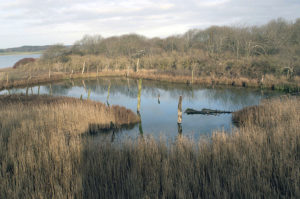
In this picture from November 15, 2009, withered stems of Phragmites australis are seen in the depression in the foreground, while Bolboschoenus (the reddish plants) forms a zone along the southern and western edges of the pond proper. Along the northern and eastern edges of the pond, Phalaris arundinacea is dominant together with Bolboschoenus, Typha latifolia (green plants to the far right), and Rumex maritimus (small patch of pale green plants to the left). The Sambucus shrubs north of the pond are now very old, their trunks covered by a yellow lichen, presumably Xanthoria parietina. In the background young forest on Vestermark. Again, mallards and teals are resting in the pond. (Photo copyright © by Kaj Halberg)
Kulmade
Until 1979, an area south-east of the farmhouse, west of Østerskov, was a grass field, utilized for cattle grazing and hay production. In this field, Bellis perennis was so numerous during the 1970s that a large part of the field appeared white. In the old days, before this area was drained, the field was a meadow, named Kulmade (’coal-black meadow’) – very likely because the soil here is black peat.
Following the destruction of the drainage pipes in 1980, the groundwater level rose, and the field once again turned into a meadow. Every spring, during the 1980s, the vegetation here was completely dominated by Ranunculus repens, which is still very common here. In the 1990s, various grasses began to dominate, especially Agrostis stolonifera and Alopecurus geniculatus, with large growths of Phalaris arundinacea, Persicaria amphibia, Mentha aquatica, Solanum dulcamara, Alopecurus pratensis, Bidens tripartita, Potentilla anserina, and Deschampsia cespitosa. Most of these plants are still present, and Carex pseudocyperus displays several fine tussocks.
During the 1990s, cormorants were breeding in large numbers right out to the western edge of Østerskov. At this time, several guano-tolerant species grew along the forest edge, including Oxybasis rubra, Chenopodium polyspermum, Persicaria lapathifolium ssp. pallidum, and Atriplex prostrata. In 2006, there were not nearly as many cormorants, and the above-mentioned plants had disappeared, except Oxybasis, which has since also vanished.
Until 1979, Kulmade was a grass field. In this picture from May 22, 1978, Bellis perennis is so numerous that a large part of the field appears white. Flowering Ranunculus repens and Prunus spinosa are also seen. (Photo copyright © by Kaj Halberg)
Kulmade, shortly after the harvest of hay, June 15, 1978. (Drawing copyright © by Jens Gregersen)
Following the destruction of the drainage pipes in 1980, the groundwater level rose, and Kulmade once again turned into a wet meadow. In spring, the vegetation is still completely dominated by Ranunculus repens. In this picture, from June 11, 1997, Alopecurus pratensis and Cirsium palustre are also seen. In the background Østerskov, which has been much affected by breeding cormorants. (Photo copyright © by Kaj Halberg)
By 2001, vegetation in Kulmade was dominated by various grasses, here Agrostis stolonifera and Phalaris arundinacea, together with Mentha aquatica. In the background Østerskov. – July 12, 2001. (Photo copyright © by Kaj Halberg)
Today, a large growth of Persicaria amphibia is found in the western part of Kulmade. – July 18, 2017. (Photo copyright © by Kaj Halberg)
A fine specimen of Carex pseudocyperus, Kulmade, April 30, 2022. In the background young forest on Sydmark, to the left a large Salix cinerea. (Photo copyright © by Kaj Halberg)
Østerdam
As early as in the 1930s, a humid depression had already been established in a small area in an old protected field in the south-eastern corner of the island. In 1938, this area was dominated by vegetation of Ranunculus repens, Elymus repens, and Potentilla anserina.
Prior to the destruction of the drainage pipes in 1980, tall perennials had taken over the depression, dominated by Phalaris arundinacea, Urtica dioica, and Filipendula ulmaria. With the rising groundwater level, a small pond, called Østerdam (‘eastern pond’), was present here for the major part of the year.
During the first half of the 1980s, this pond was almost covered by a huge growth of Ranunculus peltatus, but by 1991 this species had been replaced by Phalaris arundinacea, Sparganium erectum, Typha latifolia, Bolboschoenus maritimus, Schoenoplectus tabernaemontani, Persicaria amphibia, Bidens tripartita, and Solanum dulcamara (fig 3a).
Eleocharis palustris and Rorippa palustris were scarce, and along the northern edge of the pond was a growth of Oxybasis rubra, which benefitted from guano of breeding cormorants. The pond had spread into a growth of Populus x canescens, and the rising water level caused many of these to topple.
In 2006, the pond had about the same distribution as in 1991, but the vegetation had changed dramatically (fig 3b). Around the edge of the pond, Phalaris arundinacea still formed a zone, but in the pond proper, Typha latifolia and Bolboschoenus maritimus had increased. Sparganium erectum, Eleocharis palustris, and Rorippa palustris had disappeared, whereas Mentha aquatica, Rumex maritimus, and Veronica catenata were new to the area.
In 2022, Bolboschoenus maritimus had increased dramatically, now covering almost the entire pond, together with a dense tangle of Solanum dulcamara. Typha latifolia was now restricted to a small area in the northern part, and Phalaris arundinacea had also decreased significantly. As early as 2018, Schoenoplectus tabernaemontani, Rumex maritimus, and Veronica catenata had disappeared, and in 2022 Mentha aquatica could not be found. The pond is now completely covered by vegetation, and a pond proper is only formed during the winter months.
Fig. 3. Vegetation types in and around Østerdam, 1991 (a) and 2006 (b). (After Halberg 2006).
Signs:
o = young wood of Populus x canescens.
• = young wood, dominated by Fraxinus excelsior.
… = spiny shrubs of Prunus spinosa, Crataegus monogyna, and Rosa canina.
– – – = border between the pond and a growth of Populus x canescens.
x = concrete post with an engraved number.
Dominating herbs: B = Bidens tripartita. Ba = Phalaris arundinacea. C = Oxybasis rubra. E = Leymus arenaria. Ep = Eleocharis palustris. Ga = Galium aparine. K = Elymus repens. Ma = Mentha aquatica. Pa = Persicaria amphibia. Ph = Phragmites australis. Rm = Rumex maritimus. S = Bolboschoenus maritimus. Sp = Sparganium erectum. St = Schoenoplectus tabernaemontani. T = Typha latifolia. U = Urtica dioica.
During the first half of the 1980s, Østerdam was almost covered by a huge growth of Ranunculus peltatus. The trees are Populus x canescens. – May 24, 1984. (Photo copyright © by Kaj Halberg)
Østerdam with large growths of Typha latifolia and Solanum dulcamara (in front), May 22, 2017. In the background a young wood south of Østerskov, with breeding cormorants. (Photo copyright © by Kaj Halberg)
Humid depressionin the northern part of the old protected field south of Østerskov, with Ranunculus ficaria and Phalaris arundinacea, April 27, 2022. During periods with a high water level, this depression is connected with Østerdam. (Photo copyright © by Kaj Halberg)
Fig. 4. Vegetation map of Vorsø 1960 (from Jessen 1968).
Fig. 5. Vegetation map of Vorsø 1991 (from Halberg 1996).
Fig. 6. Vegetation map of Vorsø 2006 (from Halberg 2006).
Explanation to figs. 4-6.
1: littoral vegetation
2: meadow and swamp
3: grassland without trees
4-6: grassland with successively more trees
7: vegetation of Chamaenerion angustifolium-Rubus idaeus without trees
8-10: vegetation of Chamaenerion-Rubus with successively more trees
11: mosaic of grassland with many trees, and vegetation of Chamaenerion-Rubus with many trees
12-13: Salix shrubs
14: thorny shrubs
15: young wood
16: trial plots
17: Sambucus shrubs
18: open herb layer without dominating species, or arable land (1960)
19: dense vegetation of Anemone nemorosa and/or Ranunculus ficaria
35: pond, ditch
Sc: shrubs of Salix cinerea
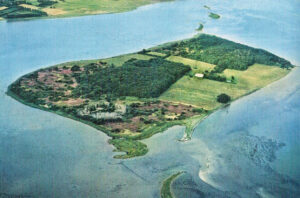
Fig. 7. Aerial photograph of Vorsø from south-west, July 1981. In front, the north-eastern tip of the islet Vorsø Kalv is protruding. Above it is a system of old semi-circular spits, named Kalvøerne, overgrown by littoral meadows, and, for the major part, connected to Vorsø proper. A younger, sandy spit is seen to the right. The white trees in the foreground is Vestre Remise, which, since the 1960s, has been housing a colony of cormorants, whose guano is covering the trees. This plantation is situated on one of the fields, Vestermark, which was protected in 1928. Many open areas were still present in this field in 1981, dominated by grasses and Chamaenerion angustifolium (reddish parts). North of the western wood, Vesterskov (centre of the picture), the field had been taken over by young forest. In the background is the other old forest, Østerskov. Cormorants began breeding here in 1976, and some parts are whitened by their guano. During the 1990s, Østerskov was completely destroyed by a combination of cormorant guano and Dutch elm disease. Today, a young wood of Acer pseudoplatanus is dominating here. North-east of this forest, the old protected field Østermark had already been almost completely taken over by a young wood in 1981, dominated by Acer pseudoplatanus. Those fields that were protected in 1978 (the open parts to the right, between the two forests, and a smaller area near the north coast), were covered in a dense carpet of grasses in 1981, mixed with Chamaenerion angustifolium and other herbs. The small, isolated plantation to the right is called Tepotten (‘the teapot’) – so named because of a tiny waterhole in the centre of it. (Photo Flemming Christensen, copyright © by Kaj Halberg)

Fig. 8. Aerial photograph of Vorsø from south-west, August 1997. By now, Chamaenerion angustifolium has almost disappeared from the old fields, but is dominant in the eastern part of the new field Sydmark (far right). Bushes and young trees have spread considerably. The pale parts in front are dominated by Arrhenatherum elatius. The guano from cormorants has by now had a heavy impact on Østerskov. (Photo copyright © by Eigil Holm)
Fig. 9. Aerial photograph of Vorsø and Vorsø Kalv from south-west, October 13, 2012. The reserve is by now largely covered in forest, and open areas with grass and other herbs are only found in the south-western corner, on the islets Vorsø Kalv and Langøerne, on Kulmade (the green meadow to the right), and a few places on Nordmark and Sydmark (left of the tall trees at the northern coast, and in the right side of the picture, centrally). (Photo copyright © by Eigil Holm)
References (all in Danish)
Dal, T. & P. Fabricius 2013. Vorsø Skov VII. Registrering af vedvegetationen i skovene og udvalgte prøveflader på Vorsø 2012. Rapport til Institut for Geovidenskab og Naturforvaltning, Københavns Universitet. Available on the internet: curis.ku.dk/portal/files/147630305/Vors_2012.pdf
Halberg, K. 1996. Flora og vegetation på naturreservatet Vorsø 1930-1992. Flora og Fauna 101: 79-100.
Halberg, K. 2006. Vegetationsudviklingen på naturreservatet Vorsø 1929-2006. Rapport til Aage V. Jensens Fonde.
Halberg, K. & J. Gregersen (red.) 2010. Vorsø – et fristed for naturen. Eigil Holms Forlag.
Jessen, K. 1968. Flora og vegetation på reservatet Vorsø i Horsens Fjord. Botanisk Tidsskr. 63: 1-201.
Wiinstedt, K. 1938. Vegetationen paa Reservatet Vorsø i Horsens Fjord. Botanisk Tidsskr. 44: 260-306.
(Uploaded February 2017)
(Latest update November 2022)
